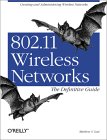802.11 Wireless NetworksThe Definitive Guide
|

|
 Diese Seite wurde seit 12 Jahren inhaltlich nicht mehr aktualisiert.
Unter Umständen ist sie nicht mehr aktuell.
Diese Seite wurde seit 12 Jahren inhaltlich nicht mehr aktualisiert.
Unter Umständen ist sie nicht mehr aktuell.
 Zusammenfassungen
Zusammenfassungen
 As a network administrator, architect, or security professional, you need to understand the capabilities, limitations, and risks associated with integrating wireless LAN technology into your current infrastructure. 802.11 Wireless Networks: The Definitive Guide provides all the information necessary to analyze and deploy wireless networks with confidence.
As a network administrator, architect, or security professional, you need to understand the capabilities, limitations, and risks associated with integrating wireless LAN technology into your current infrastructure. 802.11 Wireless Networks: The Definitive Guide provides all the information necessary to analyze and deploy wireless networks with confidence.
Over the past five years, the world has become increasingly mobile. Traditional ways of networking have altered to accommodate new lifestyles and ways of working. Wireless networks offer several advantages over fixed (or wired) networks, with mobility, flexibility, ease and speed of deployment, and low-cost at the top of the list. Large productivity gains are possible when developers, students, and professionals are able to access data on the move. Ad-hoc meetings in the lunch room, library, or across the street in the café allow you to develop ideas collaboratively and act on them right away. Wireless networks are typically very flexible, which can translate into rapid deployment. Once the infrastructure is in place, adding new users is just a matter of authorization.
After a general introduction to wireless networks, this practical book moves quickly into the gory details of the 802.11 standard. If you ever need to debug a wireless network that isn't working properly, you'd better understand this material. 802.11 MAC (Media Access Control), detailed 802.11 framing, WEP (Wired Equivalent Privacy protocol), 802.1x, management operations, and the PCF (point coordination function) are all covered in detail. Author Matthew Gast also supplies impressive detail on the physical layers.
As for getting a wireless network up and running... Gast offers clear, no-nonsense guide for using 802.11 on Windows and Linux, using and selecting access points, making deployment considerations, and seeing to 802.11 network monitoring and performance tuning. In the final section of the book, he summarizes the standardization work pending in the 802.11 working group.
If you're looking for one book that provides a full spectrum view of 802.11, from the minute details of the specification, to deployment, monitoring, and troubleshooting, 802.11 Wireless Networks: The Definitive Guide is worth its weight in gold.
 Kapitel
Kapitel 
- Physical Layer Overview
- 15. 802.11 Network Deployment

- 1. Introduction to Wireless Networks (Seite 1 - 6)
- 2. Overview of 802.11 Networks (Seite 7 - 22)
- 3. The 802.11 MAC (Seite 23 - 51)
- 4. 802.11 Framing in Detail (Seite 51 - 85)
- 5. Wired Equivalent Privacy (WEP) (Seite 86 - 98)
- 6. Security, Take 2: 802.1x (Seite 99 - 113)
- 7. Management Operations (Seite 114 - 139)
- 8. Contention-Free service with the PCF (Seite 140 - 150)
 Dieses Buch erwähnt ...
Dieses Buch erwähnt ...
 Dieses Buch erwähnt vermutlich nicht ...
Dieses Buch erwähnt vermutlich nicht ... 
 Nicht erwähnte Begriffe | Verfügbarkeit / availability, Wireless Computing an Schulen |
 Tagcloud
Tagcloud
 Volltext dieses Dokuments
Volltext dieses Dokuments
 Standorte
Standorte 
 Bibliographisches
Bibliographisches 
 Beat und dieses Buch
Beat und dieses Buch
Beat hat dieses Buch während seiner Assistenzzeit an der ETH Zürich ins Biblionetz aufgenommen. Die bisher letzte Bearbeitung erfolgte während seiner Zeit am Institut für Medien und Schule. Beat besitzt ein physisches, aber kein digitales Exemplar. Es gibt bisher nur wenige Objekte im Biblionetz, die dieses Werk zitieren.










 Firewall
Firewall Linux
Linux Projektmanagement
Projektmanagement Sicherheit bei WLAN
Sicherheit bei WLAN WLAN / Wireless LAN
WLAN / Wireless LAN , 173 kByte)
, 173 kByte) 



 Biblionetz-History
Biblionetz-History